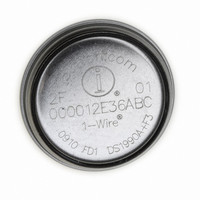DS1922E-F5# Maxim Integrated Products, DS1922E-F5# Datasheet - Page 21

DS1922E-F5#
Manufacturer Part Number
DS1922E-F5#
Description
IBUTTON TEMP LOGGER 4KBit F5
Manufacturer
Maxim Integrated Products
Series
iButton®r
Datasheet
1.DS1922E-F5.pdf
(44 pages)
Specifications of DS1922E-F5#
Rohs Information
IButton RoHS Compliance Plan
Memory Size
512B
Memory Type
NVSRAM (Non-Volatile SRAM)
Lead Free Status / RoHS Status
Lead free by exemption / RoHS compliant by exemption
The last step to begin a mission is to issue the Start
Mission command. As soon as it has received this com-
mand, the DS1922E sets the MIP flag and clears the
MEMCLR flag. With the Immediate/Delayed Start Mode
(SUTA = 0), after as many minutes as specified by the
mission start delay are over, the device wakes up,
copies the current date and time to the Mission
Timestamp register, and logs the first entry of the mis-
sion. This increments both the mission samples counter
and device samples counter. All subsequent log entries
are made as specified by the value in the Sample Rate
register and the EHSS bit.
If the Start Upon Temperature Alarm mode is chosen
(SUTA = 1) and temperature logging is enabled (ETL =
1), the DS1922E first waits until the start delay is over.
Then the device wakes up in intervals as specified by
the sample rate and EHSS bit and measures the tem-
perature. This increments the Device Samples Counter
register only. The first sample of the mission is logged
when the temperature alarm occurred. However, the
Mission Sample Counter does not increment. One sam-
ple period later the Mission Timestamp register is set.
From then on, both the Mission Samples Counter and
Device Samples Counter registers increment at the
same time. All subsequent log entries are made as
specified by the value in the Sample Rate register and
the EHSS bit.
The general-purpose memory operates independently of
the other memory sections and is not write protected
during a mission. All the DS1922E’s memory can be read
Figure 8. Address Registers
TARGET ADDRESS (TA1)
TARGET ADDRESS (TA2)
ENDING ADDRESS WITH
High-Temperature Logger iButton with 8KB
DATA STATUS (E/S)
______________________________________________________________________________________
BIT NUMBER
(READ ONLY)
T15
AA
T7
7
T14
T6
6
0
T13
T5
PF
5
at any time, e.g., to watch the progress of a mission.
Attempts to read the passwords read 00h bytes instead
of the data that is stored in the password registers.
Because of the serial data transfer, the DS1922E
employs three address registers called TA1, TA2, and
E/S (Figure 8). Registers TA1 and TA2 must be loaded
with the target address to which the data is written or
from which data is sent to the master upon a Read
command. Register E/S acts like a byte counter and
transfer status register. It is used to verify data integrity
with Write commands. Therefore, the master only has
read access to this register. The lower 5 bits of the E/S
register indicate the address of the last byte that has
been written to the scratchpad. This address is called
ending offset. The DS1922E requires that the ending
offset is always 1Fh for a Copy Scratchpad to func-
tion. Bit 5 of the E/S register, called PF or partial byte
flag, is set if the number of data bits sent by the master
is not an integer multiple of 8. Bit 6 is always a 0. Note
that the lowest 5 bits of the target address also deter-
mine the address within the scratchpad, where interme-
diate storage of data begins. This address is called
byte offset. If the target address for a Write command is
13Ch, for example, the scratchpad stores incoming
data beginning at the byte offset 1Ch and is full after
only 4 bytes. The corresponding ending offset in this
example is 1Fh. For best economy of speed and
T12
T4
E4
4
Address Registers and Transfer Status
T11
T3
E3
3
Data-Log Memory
T10
T2
E2
2
T1
T9
E1
Memory Access
1
T0
T8
E0
0
21












